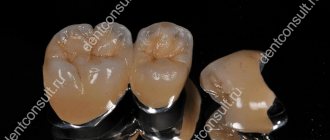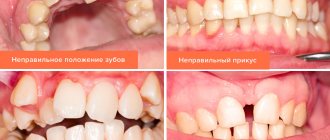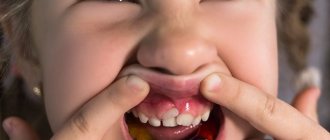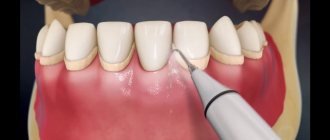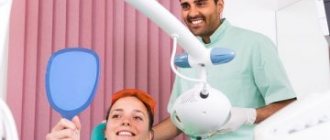3173
Dental crowding is the most commonly diagnosed dental pathology. According to statistical studies, the anomaly, to a greater or lesser extent, occurs in every third child and every second adult.
And although the vast majority of owners of such a “gift” of nature are not too worried about this, it is necessary to treat the pathology.
The types of the disease, methods of its treatment and causes will be discussed in this article.
A little theory:
Dentists, and especially we, orthodontists, very often use the term “Occlusion”, which is incomprehensible to many. Don't be alarmed, everything is very simple. I'll explain now.
Occlusion
- nothing more than the contact of the teeth of the upper and lower jaws.
In the modern world of dentistry, the understanding of occlusion is complex and includes the relationship of teeth, masticatory muscles and temporomandibular joints. And we always look at the bite precisely from the point of view of the function of the bite or its violation - bite dysfunction.
We consider occlusion as any contact between the incisal edges or chewing surfaces of the maxillary and mandibular teeth.
Why are these contacts between teeth so important?
Besides the fact that crooked teeth themselves look ugly and unaesthetic, but seriously, occlusion is very important in order to provide you with competent and optimal treatment. If you look carefully in the mirror at your teeth, at their contact with each other, you will see that the teeth have tubercles at the end, which are called fissure-tubercle contacts. And correct, stable occlusion is ensured by multiple uniform fissure-tubercle contacts of the lateral teeth, which are characterized by the presence of antagonistic cusp slopes on the occlusal surface of the contacts.
Cool and difficult with tuberculate contacts?
We’re done with the theory)) I’ll just note that correct occlusal contacts provide axial load on the teeth (we will see this in the photo of our patient), create stable central occlusion and eliminate overload of the tissues around the tooth - the periodontium.
For us orthodontists, occlusion is the central point of treatment, which should generally be aimed at optimizing the occlusal relationship of the patient's teeth with each other.
Molars are the 6th, 7th and 8th molars. Molars are also called molars, respectively. In the photo above it’s the molars. They perform the most important function in the human body - chewing and grinding food, which is why dentists often call them “chewing”. But the most harmful of the molars are the eights, or “wisdom teeth,” which can greatly harm the patient when they erupt.
So in this case, the “wisdom teeth” of the lower jaw had a fairly strong negative impact on the patient’s lower jaw, practically pushing the canine out of its place in the dentition. So, let's see.
Causes of malocclusions
Types of malocclusion
There are many causes of malocclusion. They can be divided by age groups.
In childhood, the bite is disrupted for the following reasons:
- Various genetic abnormalities.
- Unlucky heredity - the parents have an incorrect bite, or the child received too small a jaw from his mother and too large teeth from his father.
- The child’s habit of breathing with his mouth open, sucking fingers or a pacifier after teething.
- Early loss of baby teeth due to caries or their removal instead of treatment.
- Incorrect attachment of the frenulum of the tongue or lips, creating pressure on the teeth.
If these negative factors were not present in childhood, then by adulthood a person’s bite usually remains normal. However, it may fail for the following reasons:
- Jaw injuries, especially those accompanied by tooth loss.
- Extraction or loss of teeth - adjacent teeth will move to take up the vacant space.
- Inflammation of the gums, accompanied by loss of bone tissue - teeth become loose and shift.
- Eruption of wisdom teeth, especially if there is no room for them in the jaw.
In this case, the bite can deteriorate at 20, 30 and even 40 years of age.
The patient had the following condition at the time of presentation:
In the case of our patient with a bite of molars “sixes” and “sevens” it is quite positive. The “eights” on the lower jaw were removed - it was their eruption that led to the displacement of the dentition and the appearance of such an unpleasant aesthetic imbalance in the patient’s smile. But everything can be fixed!
Displacement of the lower canines forward from the upper canines on the right and left
3rd class for canines on the right and left
Shift of the midlines due to the lower jaw to the right
Crowded position of teeth in the lower jaw
Lack of space for the lower right canine
And in general - narrowing of the dentition
Let me remind you that the main, basic desire of the patient is to avoid the presence of braces in the oral cavity.
As I wrote earlier, the patient wanted the treatment of crowded teeth to be as aesthetic and unnoticeable as possible, explaining that he was not ready to walk with glands in his mouth and be an “iron man” with iron structures in his mouth. Morally, at his young and active age, it’s hard, you’ll agree. After all, external, visible braces in this case are actually already “last century”, in the sense of technology of the last century, which has already been replaced by new, more advanced and effective technologies of the 21st century.
Based on the wishes of the young man, I proposed two options for treating crowded teeth and straightening canines using the following orthodontic equipment:
- Aligners
are transparent aligners, which are worn in the process of correcting the bite unnoticed by others. The aligners can be removed when eating and brushing your teeth.
- and lingual braces
- invisible braces that are attached to the inside of the teeth and are also not visible to others. But they are felt by the patient when worn. and removing lingual braces is not possible until the end of the entire treatment
Stages
The pathology has three stages of progression:
- simple - the error within a single part of the jaw is no more than 3 mm;
- medium – the size of the deviation is much larger and reaches 6 mm;
- strong - over 7 mm, which is considered an advanced state of the structure of the jaw row.
The phenomenon can be characteristic of one jaw or its fragment, or of the entire dentition.
What is a mesial bite, what methods are used to correct the defect in adults and children?
Come here and read reviews about Clarity ceramic braces, as well as a lot of useful information about the systems.
At this address https://orto-info.ru/zubocheliustnye-anomalii/okklyuzii/otkryityj-prikus.html we will talk about the treatment of open bite in children.
As a result, the treatment option using aligners was unconditionally accepted
Why did the patient come to me with the problem of crowded lower teeth?
Still, my orthodontic experience is taking its toll, and recommendations are coming from grateful patients (thank them very much for this!). And in this case, the patient came on the recommendation of his sister, who was my patient several years ago with a very similar clinical situation in the oral cavity (narrowing, crowding of teeth nearby, slight crowding of teeth on the upper and lower jaws).
Did the patient know about the aligners?
Surprisingly, he was not motivated to get aligners. The patient knew about treatment with lingual braces (read on the Internet, saw it with friends), but he had never heard of treatment with aligners. I told him that there is a treatment method using transparent aligners (an alternative to braces), which need to be changed every 2 weeks. Aligners are more comfortable to get used to and wear than braces; oral hygiene does not suffer during treatment with aligners. And what is important, given how busy people are nowadays, is that the patient can visit the doctor less often than with braces. And as a decisive argument, when treating his crowded teeth with aligners, there will be no dietary restrictions.
Preparation for the treatment of crowded teeth is necessary in any case
The patient had already been examined by a therapist, treated all his teeth, cleaned them, understanding that he should have entered the treatment with normal teeth. The young man regularly visits a therapist once every six months (how rare is this to see), but nevertheless, the problem of dental aesthetics due to the incorrect position of the canine in the lower dentition began to grow.
The only additional thing that was done was teeth separation
. Separation is when we slightly carefully increase the interdental spaces by comfortable grinding, in a way that is safe for tooth enamel. During the entire period of treatment, five separations of incisors and premolars on the lower jaw were carried out due to crowding - to make room for the canine.
This is a very important point. And there is no need to be afraid of it, it is natural during the treatment process and absolutely comfortable.
Diagnosis of malocclusions
Sometimes malocclusions are completely obvious to the patient - for example, it is easy to notice a diastema or serious problems such as crowding or crossbite. But sometimes the anomalies are minor and are hidden in the area of the chewing teeth. In this case, a person can live and not even know that his bite is incorrect.
Such defects are not noticeable, even to others, but are no less harmful to health than noticeable ones. Since it is impossible to recognize them on your own, it is better in this case to consult a doctor.
Usually, even a dentist can recognize such minor bite defects during a routine examination or during caries treatment. In this case, he informs the patient, describes the defect in the medical record and prescribes treatment with an orthodontist.
Sometimes malocclusions are difficult to recognize, so if the therapist finds nothing, it makes sense to visit an orthodontic specialist once, just in case, so that he can conduct a thorough examination and accurately determine whether you have problems with your bite. For diagnosis, visual examination, x-rays and computed tomography are used.
The bite can change throughout life, so it is important to visit a doctor every six months to a year. At preventive appointments, the dentist carries out cleaning, diagnoses caries and can immediately notice the slightest changes in the bite, which will be very easy to correct at the initial stage.
How was dental crowding treated with aligners?
To carry out a full course of treatment, 26 pairs of aligners were made for both jaws; treatment proceeded in parallel on both jaws, including the separation stages.
I immediately gave the patient 4 pairs of aligners; it is very easy to install them yourself - the patient needs to change them for new ones every two weeks.
Then he visited me only 2 months later. One of the previously mentioned interdental separations was carried out to help his canine, which had already begun to fall into place. And again, for a month and a half, the patient forgot about the doctor’s existence. But the doctor does not forget about the patient. This is the beauty of treatment with aligners - it is invisible to the patient)
Let's smile together!
I want to tell you about such an important factor in treatment as emotions. If the attending physician, as a rule, always directs emotions in a positive direction, since correcting the patient’s bite is his profession, then for the patient, every moment of improvement in his current condition, or vice versa, every small anxious moment is a surge of emotions. That's right, because the patient begins a new life with a beautiful smile, and for him in this new life there is already a place for openness and positive impressions.
During treatment with aligners, as agreed, the patient very actively communicated with me using messengers.
What periods would I like to highlight in his emotions:
The first period of treatment for crowded teeth with aligners is “anxiety”
After installing the attachments and giving the patient the first set of aligners, I was faced with his slight anxiety about tooth sensitivity; the patient constantly asked me if it was normal that one or the other tooth was sensitive when biting (to which I replied that this was absolutely normal and this is a period of getting used to the aligners), but after the first week and the patient got used to the aligners, his anxiety also went away. Later, when changing each set of aligners to a new one, he was already calm about the slight sensitivity of his teeth in the first 2 days of wearing the new set.
The second period of treatment for the patient is “satisfaction, sharing impressions”
Subsequently, the patient was so pleased with the chosen treatment method that he constantly told me funny / incidental stories related to removing the aligners in a restaurant or on vacation, or brushing his teeth at work after eating:
- Once
I wrapped my aligners in a napkin in the cafeteria at work and they were taken away along with the tray and thrown away, the patient panicked, called me and asked what he should do?! I suggested either looking in the trash or ordering a new set, but in the end he, a colleague and a canteen worker found them in a trash container! HOORAY) - Second story
. I was on a business trip, went to a restaurant for lunch and didn’t take the container with me, took off the mouth guards before eating, put them on a napkin next to me (for some reason I took off the mouth guards right at the table), a family with children was sitting at the next table and the children began to laugh when they saw how he took off his mouthguards, telling his parents: “Look, the guy is taking off his dentures”:
After all, aligners are generally transparent and invisible
The third period of treatment for crowded teeth is “complete satisfaction”
Complete satisfaction is also supplemented by an assessment of how others perceive him - “how cool he is.” Yes, this is cool, treatment with aligners is invisible, aesthetic, every day it adds inner self-confidence to the patient, liberates the person and reveals his potential for communication with friends. This is really cool!
Fourth period of treatment. There is no more crowding of teeth: “I will be bored without aligners”
At the end of the treatment, the patient already said that he did not know how he would live after the aligners, that he would miss them and whether it was possible to continue wearing them after treatment. Do not take this literally, the patient just had a little anxiety - the fear of losing the result he was very satisfied with!
The patient began to smile and laugh much more often!
But this is important for me, as a treating orthodontist. The patient’s smile is the most important gratitude for my work.
Maintaining the result after bite correction
As we noted above, when correcting occlusion in adults, it is especially important to consolidate the result after treatment. Since the jaw has long been formed, the teeth have already become “accustomed” to their incorrect position, and after removing the braces or aligners they will want to return to it.
To prevent this, there is a retention period - a stage of treatment during which the patient wears retainers. These are also orthodontic structures, but much simpler and more convenient than braces and mouth guards.
Retainers come in two main types:
- Removable, in the form of caps, plates or wire structures. They need to be worn sometimes, for example, at night. Such designs are convenient and do not interfere with brushing your teeth, but it is important not to forget to wear them, otherwise your teeth will return to the wrong position.
- Fixed, in the form of a thin wire that is attached to the back of the teeth. They are covered with a composite, invisible and at the same time reliably hold the teeth together. These retainers are convenient, although they make it a little difficult to brush your teeth and are not suitable for all malocclusions.
Typically, the retainer needs to be worn one and a half to two times longer than the braces treatment lasted. That is, if the bite has been corrected for two years, you will have to wear a retainer for another 3-4. This sounds inconvenient, but in fact it is not too burdensome. In addition, during this period you will no longer need to visit a doctor.
It is very important not to neglect the retention period. Sometimes it seems that the bite has already been corrected, why torture yourself by wearing some kind of construction? But if the teeth return to their incorrect position, the entire orthodontic treatment will have to be repeated again - that is, you will have to wear braces again for 1-2 years, and then still wear a retainer.
Interesting moments that the patient described about the sensations on the aligners
The patient noted in the messenger that his tooth (fang) was moving and he was afraid to remove the aligner along with the fang! The movement of the canine as a result of removing crowding does occur, and as a result, tooth mobility can actually be felt. But since all dental movements during treatment with aligners are planned in advance, and the patient’s teeth are reliably protected in the aligners, all worries were removed.
As I told you earlier, once on a business trip in a restaurant, when he forgot the container and put the aligners next to him on a napkin, the children at the next table laughed that he had taken off his dentures
In fact, aligners can and should be stored in a special container while brushing your teeth or eating
Problems of treating crowded teeth with aligners
There were no problems at all with wearing the aligners. The only thing is that the activator came off once - this was after six months, but this was quickly eliminated and did not affect the course of treatment.
There was a case when a patient went on vacation and did not take his mouthguard retainer with him - his internal retainer came unstuck and the tooth moved back a little, “rotated” as orthodontists say. Now the problem is over.
Determine character by tooth shape
03.01.2017
Scientists have learned to determine the character and even the fate of a person by a variety of manifestations of appearance - by the color and shape of the eyes, by the length of the fingers and toes, by the oval of the face and the size of the mouth. So is it any wonder that you can guess the character and inclinations of people just by their teeth?
The science of physiognomy is engaged in this interesting matter, the beginnings of which arose in ancient times in China. The Chinese, when talking about the psychological characteristics of a person based on their appearance, pay a lot of attention to the size and shape of their teeth. It is believed that it is the teeth that store encrypted information about a person’s future, his relationships with the world and people around him, and personal qualities. You just need to learn to see this information and interpret it correctly.
Of course, the happiest and most pleasant people are those who have straight, white, healthy teeth. Agree, it would be strange if people with small crooked yellow teeth were considered lucky. After all, beautiful, blemish-free teeth indicate a person’s good health and heredity, and this gives many chances for a happy and long life. However, not everything is so simple and unambiguous.
It is possible to judge something by the teeth only if they have not been touched by a dentist’s instrument. We don’t judge a person’s character by the shape of his nose after a plastic surgeon has worked on it. And at the same time, if a person takes care of his teeth, regularly visits the dentist, cleans them regularly and monitors the health of his gums, a lot can be said about him. Such people are responsible, take their appearance and health seriously, are financially prosperous, and are often quite successful in public and personal life.
If the mouth has even, but yellow and diseased teeth, some are missing or will leave the oral cavity in the near future, many conclusions can also be drawn about such a person. Most likely, he is lazy, careless and irresponsible, not everything goes well in life and is often unlucky, problems with money, difficult relationships with his family and the outside world. There is a second option - maybe this person is doing well, but he is simply terrified of the dentist.
But there are features of teeth that a person cannot influence on his own; they are given to us by nature and our ancestors. It is precisely by these individual characteristics that physiognomy is used to predict and determine human character and destiny.
You can also make predictions for the future based on baby teeth, just like with molars. For example, if the first teeth do not erupt for a long time, it means that the child will be rich and influential in the future. And if baby teeth don’t fall out on time, he will live a long life.
1. Owners of “horse teeth” are truly lucky and darlings of fate. They will have a long happy life, good luck, wealth, many friends and a good family. The owners of such teeth are good, energetic people who do not know fatigue and obstacles in life. They are good family men, loyal friends. However, such people have one small drawback - since they themselves are honest and frank, they easily succumb to the deception of others.
2. Those with protruding teeth are strong, strong-willed individuals. They achieve good success in life because they make great efforts to achieve this. There are no barriers for them; they do not ask or accept anyone’s help. It often happens that when they grow up, they leave their father’s house, build a career and start a family far from their homeland.
3. The gap between the front incisors is considered a good omen , a sign of wealth and longevity, energy and unpredictability. The extraordinary character of such people often becomes a stumbling block between them and others. But even gaps between all the teeth in the mouth are a sign of resourcefulness, a tendency to evasion. If the front teeth collide with each other and are crowded together, this is considered a sign of poor health.
4. Large incisors say the following about their owners - they are sociable, talkative, leaders of any company. Their whole life is a desire for fame, success, wealth, to conquer peaks and overcome obstacles. They are good friends, always come to the rescue, but in return they demand the same faithful friendship.
5. If the teeth are round, even, and fit tightly together like pearls in one row, they are called “garnet teeth.” People with such wealth in their mouths are usually smart and successful, as well as happy in life and in marriage.
6. People who are adventurous and cunning, like foxes, usually have small, sharp teeth They are interesting conversationalists, however, they are too superficial people who are difficult to convince of anything. They are flighty and frivolous, have many affairs, often get married and just as often and easily get divorced. Adventure is in their blood. They like to set high goals for themselves and are sure to achieve them. It should be noted that such people often turn out to be talented and extraordinary individuals.
7. Protruding fangs are a sign of success with the opposite sex and happiness in family life. Such people are successful in everything and easily achieve their goals.
8. Crooked teeth often become precisely that flaw in appearance that pushes a person to achieve his goal no matter what. Such people are persistent, have good intuition, and feel the emotions and moods of others. They are resourceful and find a way out of any situation. People with crooked teeth often have influential connections and many love affairs.
The ancient Chinese paid attention not only to the shape and location of a person’s teeth, but also to their number. It was believed that the more teeth there are in the mouth, the more happiness awaits a person on the path of life. Moreover, to become poor and unlucky, it is enough to have less than 30 teeth. It turns out that the line between successful and unsuccessful fate is very thin, and it is enough to lose only 2 teeth to lose fortune from your hands.
But not only the Chinese drew parallels between human character and dental characteristics. There were all sorts of beliefs and signs associated with teeth in Rus', England and Scotland.
However, it is worth considering that physiognomy is not an exact science and does not say anything with certainty. Don’t despair if your teeth are not perfect, because any character flaw can be corrected with hard work and self-improvement. Great desire and diligence will certainly bear fruit in the form of financial well-being. But your dentist will definitely take care of your teeth. It is very important to start prevention from an early age, because the sooner you start treatment, the more noticeable and better the results will be. And then you and your children will smile with all 32 teeth until old age!
Posted in Parents by biglamed | Tags: teeth straightening, baby teeth, Orthodontic treatment, orthotropy, pathology, occlusion
My comment on this treatment:
I am satisfied with the result of the treatment and, probably, with the entire treatment process (even the slight anxiety and scrupulousness of the patient), it is nice to see in the end a satisfied, grateful and constantly laughing patient.
Now let’s imagine what would happen if the treatment of crowding began with lingual braces:
Yes, if the patient had rejected the aligners as a way to correct the bite, then, apparently, the choice would have fallen on lingual braces (considering that initially the patient did not want visible methods of correction)
When choosing lingual appliances as a treatment, I assume that the treatment would be more difficult for the patient.
Considering his increased anxiety and scrupulousness:
- he would not be able to get used to the violation of diction when wearing lingual braces (a lisp, which would definitely be present), and for him this would be a very important aspect associated with constant communication at work,
- he would not be satisfied with his oral hygiene, pain and discomfort when getting used to the braces system (more pronounced than the sensations with aligners),
- he would not be happy with the constant discomfort for his tongue.
Therefore, both the patient and I are very pleased with the aligners - our choice of treatment method and are satisfied with the results obtained!
Your orthodontist, Olesya Ageeva
Prevention
As preventive measures to somewhat minimize the risk of developing such an anomaly, we can recommend:
- regular dental consultations;
- control over the growth and formation of oral organs in children;
- getting rid of bad habits that provoke pathology;
- ensuring timely prosthetics in case of fairly early amputation of baby teeth;
- prevention of childhood rickets;
- proper and balanced nutrition, rich in calcium, vitamins and microelements.
Do you really need lingual braces to treat crowded teeth as your doctor advises?
Are you ready to carry this pile of iron in the form of braces - even cool lingual ones - in your mouth for the entire duration of treatment (a year or two)?
Rub your tongue against them, polish them until they shine, eliminating pieces of food? You will definitely be rubbing not covertly, but clearly, unpleasantly and constantly. Braces are uncomfortable and not aesthetically pleasing. You can have a high-quality consultation with our orthodontists and understand - what if your case of crowded teeth can be perfectly cured with aligners? If aligners can do it, then why subject yourself to self-torture with braces? So, we offer consultation on crowded teeth. Useful for you. The Star Smile company operates in more than 70 cities of Russia and will be able to offer you competent consultation with an orthodontist in your city.
Take the first step towards comfortable treatment.
Bite correction using braces
Braces for correcting malocclusion
The most common way to correct a malocclusion in adulthood is to install braces. Braces are clasps that are attached to the teeth and connected to each other by a metal arch.
There are several types of braces with their own characteristics, advantages and disadvantages.
Metal
metal braces
Both the clasps and the bow are made of metal. Such braces are considered classic; they are most often installed because of their versatility and cost-effectiveness.
Pros:
- Suitable for any malocclusion.
- High strength.
- Low cost.
- The fastest bite correction.
Minuses:
- Lowest aesthetics - braces are too noticeable.
- Unpleasant taste and sensation in the mouth.
- They are not suitable for people with metal allergies - they have to select alloy options, often more expensive.
Ceramic
Ceramic braces
In this case, braces are made of ceramic, similar in color to tooth enamel. The arc remains metal, but is painted white.
Pros:
- Quite high aesthetics, braces are almost invisible.
- Less likely to cause irritation and allergies.
Minuses:
- They cost more than metal ones.
- More fragile, treatment takes longer.
- Not suitable for the most severe malocclusions.
Sapphire
These braces are made from artificial sapphires - they are transparent and shiny, like diamonds.
Pros:
- Aesthetic - relatively noticeable, but look like a decoration for the teeth.
Minuses:
- More expensive than metal and ceramic.
- More fragile.
Combined
Combined braces
An option in which ceramic or sapphire braces are installed on the front (usually only the upper) teeth, and metal structures on the back (and lower) teeth.
Pros:
- Quite high aesthetics - the side teeth are still not visible when smiling and talking.
- The cost is lower than braces made entirely of ceramics or sapphires.
- Copes with most malocclusions.
Minuses:
- They still cost a little more than regular metal braces.
- They are not suitable if the bite is seriously disturbed on the front teeth.
- Still uncomfortable if you have a metal allergy.
Lingual
Lingual braces
These are ordinary metal braces that are installed not in front, but in the back, on the side of the tongue.
pros:
- Complete invisibility.
- An excellent effect in correcting some malocclusions - for example, they do a good job of moving the jaw forward.
Minuses:
- The tongue is often injured and diction is impaired.
- They are more expensive than all types of braces.
- Ineffective for many malocclusions.
- Not suitable for people with metal allergies.
Plastic
These braces are made of light plastic, but they are installed very rarely due to numerous shortcomings.
Pros:
- Lowest cost.
- Relative aesthetics - for some time they are invisible on the teeth.
Minuses:
- Fragility - braces break easily and are not suitable for most malocclusions.
- Over time, the plastic absorbs food coloring and darkens, so that the braces are no longer aesthetically pleasing.
- Sometimes plastic causes allergies.
You cannot choose braces on your own; you need to do this together with your dentist. After he examines your teeth, he will make a conclusion whether you can get any other braces other than metal ones, whether lingual braces are right for you, and what type of design will be most effective in your case.
Classic metal braces cope with most malocclusions, so if the result is more important to you than aesthetics, it is better to use them.
